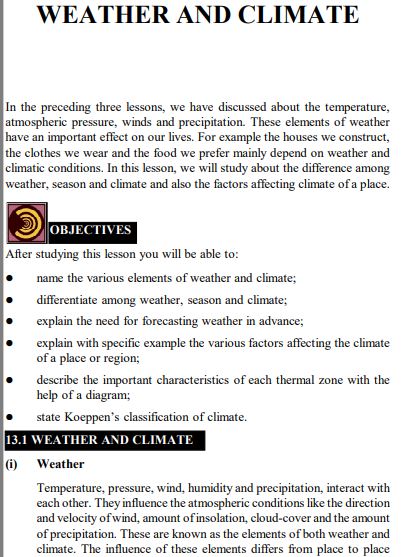Climate and Weather Notes PDF Quick download link is given at the bottom of this article. You can see the PDF demo, Size Of the PDF, Page numbers, and direct download Free PDF of Climate and Weather Notes using the download button.
Cliamate And Weather Notes For Students PDF Free Download

Explanation Of Weather and Climate In Pdf
This PDF helps the students of class 12th, 11th and 10th to understand climate in their geography subject.
In the last three lessons, we have discussed temperature, atmospheric pressure, winds and rainfall.
These elements of the weather have a significant impact on our lives.
For example, the house we build, the clothes we wear and the food we prefer depend mainly on the weather and climatic conditions.
In this lesson, we will study the difference between weather, season and climate and the factors that affect the climate of a place.
Objective
After studying this lesson you will be able to:
name the different elements of weather and climate;
differentiate between weather, season and climate;
explain the need to forecast the weather in advance;
explain with specific examples the various factors affecting the climate of a place or region;
describe the important features of each thermal zone with the help of a diagram;
Describe Köppen’s climate classification.
definition of weather
Temperature, pressure, wind, humidity and precipitation interact with each other.
They affect atmospheric conditions such as wind direction and velocity, amount of insolation, cloud cover and amount of precipitation.
They are known to be elements of both weather and climate.
The effect of these elements varies from place to place and time to time.
It may be confined to a small area and for a short period of time.
We often describe this effect in weather names as sunny, hot, warm, cool, cool etc. depending on the dominant weather element at a place and time.
Therefore, weather is the atmospheric condition of a place for a short period of time with respect to one or more elements.
Two places, even a short distance apart, can have different types of weather at the same time.
climate definition
The average weather conditions prevailing over a large area during a year from one season to another is known as climate.
The average of these weather conditions is calculated from data collected over a number of years (about 35 years) for a large area.
For example, Rajasthan has a hot and dry climate, Kerala has a tropical rainy climate, Greenland has a cold desert climate and Central Asia has a temperate continental climate.
The climate of a region is considered to be more or less permanent.
latitude or distance from the equator
The places near the equator are hotter than the places away from it.
The reason for this is that the rays of the sun fall vertically on the equator and obliquely in the temperate and polar regions.
As we discussed earlier, vertical rays focus on a smaller area than oblique rays.
Again, vertical rays pass a shorter distance through the atmosphere before reaching the Earth’s surface.
Therefore, the lower the latitude the higher the temperature and vice versa.
Malaysia which is near the equator is hotter than England which is far away from the equator.
height or elevation above mean sea level
We all know that mountains are colder than plains. Shimla, situated at a higher altitude, is cooler than Jalandhar, although both are at almost the same latitude.
The temperature decreases with the height of a place.
There is an average decrease of 1°C in temperature for a vertical rise of 165 meters. Thus the temperature decreases with increase in altitude.
continentally or by sea
Water is a bad conductor of heat which means it takes longer time to heat up and longer time to cool down.
Because of this moderating effect of the ocean, places near the coast have lower temperature ranges and higher humidity.
The interior of the continent has little influence of the ocean.
These places have extreme temperatures. The range of diurnal (diurnal) and annual temperature is greater in places away from the sea.
Mumbai has relatively lower temperatures and more rainfall than Nagpur, although both are located at almost the same latitude.
nature of prevailing winds
Onshore winds bring moisture from the ocean and cause rain in the area they pass through.
Offshore winds coming from the land are dry and help in evaporation.
In India, the onshore summer monsoon winds bring rain while the onshore winter monsoon winds are generally dry.
cloud cover
Usually in areas with cloudless skies such as deserts, the hot day’s sunlight causes temperatures to be very high even in the shade.
At night this heat is very rapidly radiated back from the ground.
This results in a large diurnal range in temperature.
On the other hand, Thiruvananthapuram has a very small temperature range due to cloudy sky and heavy rainfall.
| Author | NIOS |
| Language | English |
| No. of Pages | 11 |
| PDF Size | 0.7 MB |
| Category | Geography |
Note: If you want to download PPT (PowerPoint Presentation) then download from here. CLICK
Human And Economic Geography PDF
Climate And Weather Notes PDF Free Download
